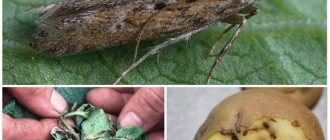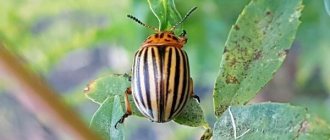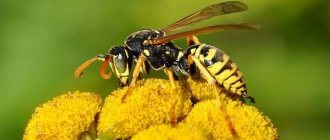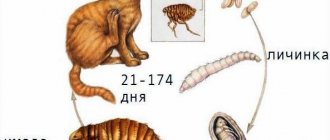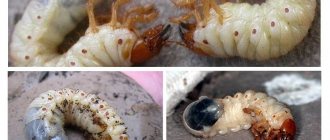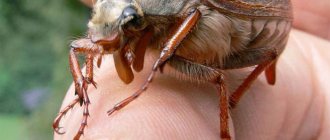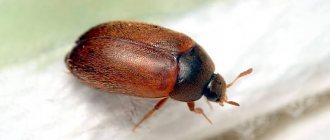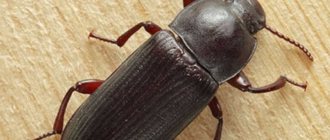- Wild animals
- >>
- Insects
If you observe, at the end of April and beginning of May you will notice that medium-sized beetles gradually crawl out of the ground and quickly fly into the air. This insect is called the cockchafer . This is the most famous pest that causes great losses in the agricultural sphere of human life. Despite this, the cockchafer is a rather interesting animal with its own habits and way of life.
Origin of the species and description
Photo: Maybug
Khrushchev is a fairly large insect. Some representatives of its genus reach thirty millimeters in length, have a characteristic wide body, black or red-brown body color. May beetles are also called beetles, and in Latin they are called Melolontha. These insects belong to the order Coleoptera and are part of the huge family Lamelidae. May beetles founded their own genus of the same name.
Video: Maybug
The Khrushchev population has experienced great leaps at different times. There were both drops and rises in the number of pests. The population was at its highest in the fifties. Then the beetles caused enormous damage to agricultural land and gardens. For this reason, farmers began to actively use pesticides to cultivate their lands. At first this significantly reduced the number of pests, then completely exterminated them. The genus of cockchafers was able to restore a high level of its population only after the eighties, when the use of certain types of pesticides was prohibited.
May beetles are amazing creatures. They have such an unusual quality as determination. The insect will fly to its intended target no matter what.
The genus of May beetles is quite large. It has twenty-four species. These are Melolontha aceris, Melolontha afflicta, Melolontha anita and many others. Nine of the species live in the territory of modern Russia. In many ways, the behavior and abilities of such beetles are similar to the behavior of ordinary wasps and honey bees. These insects also know how to remember the area and navigate it perfectly. But a significant difference from bees and wasps is the harm caused by beetles.
Body structure
The beetle's body structure is divided into segments. It consists of the head, abdominal and thoracic sections. The shell is covered with scales, which in appearance are very similar to hairs. The head consists of seven plates and ends in the shape of a club.
It is not difficult to accurately answer the question of how many legs a beetle has. His legs are attached to various parts of his chest. Each limb is used only when there is a need to use it. So how many legs does a beetle have? Three pairs, and each of them is used strictly for its intended purpose. For example, with its strong front paws, the cockchafer digs a hole in order to lay eggs, and with its hind paws it clings to a tree or foliage. The beetle has wings and elytra, they are quite heavy, which makes it look slow and clumsy. The system of sensory organs is well developed. The antennae are responsible for the sense of smell (“sniffs out” food from a kilometer distance). The organs of vision are the eyes, located on the sides of the head (view of almost 360 degrees).
Appearance and features
Photo: May beetle insect
Khrushchi are large insects. Their body length ranges from seventeen to thirty-one millimeters. The body of the animal is wide, oval in shape, sometimes slightly elongated. Body color is usually brown-red, black. The elytra follow the shape of the body and have five narrow ribs. They can be strong or weak, depending on the species.
The color of the elytra varies: red-brown, yellow-brown, with a greenish tint. Beetles have a pygidium. It is quite large, has a triangular shape (less often, blunt). At the end, the pygidium is extended into a process. In males the process is more pronounced and long, in females it is short.
The pygidium is never covered with wings. The body consists of three sections: abdomen, chest, head. The abdomen is connected to the chest motionlessly; it is divided into eight segments. The chest of the Khrushchev is covered with thick, long hairs of a yellow hue. The abdomen is also covered with thick hairs that fit tightly to the body. However, in addition to them, long hairs protrude from the abdomen. The legs of the animal are also covered with hairs, the front tibiae have two or three teeth.
May beetles fly well. And this despite all the laws of aerodynamics. From a scientific point of view, these insects have a very small coefficient of lift to fly. However, Khrushchev can travel about twenty kilometers by air in just one day.
The body of the cockchafer is very strong. It has two pairs of wings and well-developed legs. In total, the Khrushchev has three pairs of legs. With their help, the beetle securely clings to trees, plants, and branches. They also help dig deep holes in the soil. The cockchafer's mouth is gnawing.
Features of development and behavior
The flight of beetles occurs from the 2nd half of May to the end of June, isolated flights are observed until the beginning of August. But in the southern regions, the flight of beetles already begins in the 3rd decade of April.
The flight of the cockchafer is a mystery of nature. According to the laws of aerodynamics, such an insect cannot fly!!!
Usually, single males appear first, and after a week the females begin flying. Beetles begin to fly at dusk, after sunset. By midnight the flight stops. During flight, beetles sit on trees and feed. Beetles can fly out in the morning as well as at night, reacting to artificial lighting.
Different types of beetles are active at different times of the day. Both males and females fly equally well. But in some species, females fly little or not at all.
May beetle (Khrushchev) in flight
By the way, the flight of the cockchafer is a mystery of nature. According to the laws of aerodynamics known to mankind, a beetle with such a body should not fly. Its wings are not developed enough to lift such a body into the air. But the cockchafer does not know about this, and flies at speeds of up to 3 m/sec. In a day it can fly up to 20 km, rising to a height of up to 100 m.
The cockchafer lives 5-7 weeks.
And the larvae live in the soil for 2-3 years, and
Where does the cockchafer live?
Photo: Maybug
The habitat of cockchafers is quite wide, covering many continents.
It includes the following countries, zones:
- Europe, Ukraine, Russia;
- Central Asia, Caucasus;
- USA, northern Iran, India;
- China, Tibet, Japan;
- Philippines, Indochina.
Of the twenty-three species, most species live in the Palearctic zone. Only six species inhabit the zones of South and East Asia, the Indomalayan zone, and the islands that are located between Australia and Asia. A fairly large number of species of Khrushchev are found on the territory of the Russian Federation and CIS countries. Nine species live there: Melolontha hippocastani, Melolontha clypeata, Melolontha kraatzi, Melolontha aceris, Melolontha melolontha, Melolontha permira, Melolontha afflicta, Melolontha pectoralis, Melolontha gussakovskii.
For North American countries, Khrushchev pose a particular danger. In this area they have no natural enemies to control the population of these insects. The cockchafer can quickly multiply and destroy all agricultural and garden land on the mainland.
May beetles lay eggs with future offspring in the soil, so when choosing a habitat, insects pay attention to the ground. These insects never settle in areas where clay soil predominates. It is simply impossible to dig a suitable tunnel in it. Sandy, sandy loam soil is suitable for beetles. They live near forests and in river valleys. Also, when choosing a territory, the availability of food nearby and a temperate climate play a huge role.
Species of chafers of the genus Melolontha
Representatives of this genus live in Russia:
- Western May Khrushchev;
- Eastern May Khrushchev;
- Transcaucasian May Khrushchev.
They have a similar lifestyle, but their appearance is slightly different.
Western May
The insect has 2 names: Western May beetle and Western May beetle. Body length is 2.3-3.2 cm. It differs from other beetles in its high color variability. The most common variant: dark pronotum and yellow-brown elytra, abundantly overgrown with light bristles. The beetle gives the impression of being dusted with flour.
The insect is early: in the southern regions the beginning of summer occurs in mid-April. Among garden plants they prefer plum.
Habitat: most of Europe. In the north, May beetles are found all the way to the Moscow region. The southern one is limited to the Black Sea.
Eastern May
This insect is also called the eastern chafer or wild chestnut beetle. Eastern and Western Khrushchi are very similar, but differ in coloration elements and some other characteristics:
- smaller sizes (2.0-2.9 cm);
- medium sized eyes;
- the antennal club of the male consists of 7 segments, of the female - of 6, the plates of the male are 2 times larger than those of the female;
- the posterior end of the abdomen is very vertical.
The coloration of this species is very variable.
Range: all of Eurasia. The northern border runs through Arkhangelsk and Yakutia. Southern - through Odessa, Zaporozhye, Uralsk and Altai up to Shanghai.
May beetles of the genus Melolontha
Transcaucasian May
Length 2-3 cm. The color of the abdomen, head and pronotum is black. The elytra are yellow-brown and shiny. The larva is no different from the Western and Eastern Khrushchev. Range: Southern Europe and the Caucasus.
What does the cockchafer eat?
Photo: Maybug
May beetles are the most famous pests. These are insects that pose a double threat to land. They cause harm both as adults and at the larval stage. Such beetles appear right during the period of active bud opening and flowering of trees. They manage to cause enormous harm to young plants. Adult beetles have a fairly simple diet. It includes only leaves of bushes and trees. They prefer willow, linden, oak, birch, cherry, maple, plum, pear, and many other fruit trees.
To consume food, adult beetles use their powerful mouthparts. It consists of two jaws that can deftly crush leaves and even the bark of young trees. In search of food, the cockchafer can fly about twenty kilometers every day. At the same time, it can develop good speed for a relatively small insect.
During its flights, Khrushchev can destroy entire forests and gardens in Russia, Europe, and CIS countries. However, such destructive effects do not last long. Khrushchevs fly for no more than forty days.
Despite the enormous harm caused by adult beetles, beetles are most dangerous at the larval stage. They have an excellent appetite.
The larval diet includes:
- strawberry roots;
- roots of a wide variety of vegetables;
- roots of fruit and berry trees;
- potato;
- corn roots;
- roots of larch, spruce, pine, cedar, birch;
- lawn grass roots.
The larvae that are older have the greatest appetite. There is evidence that one larva, which is at least three years old, can completely eat the roots of a pine tree in just one day.
Prevention
- The simplest agrotechnical method against the pest is spring digging of the soil in the beds and in the tree trunks . At this time, the larvae are easy to spot. Tillage is mandatory for virgin areas. On such lands there is always a large concentration of the pest.
- The vegetable garden and garden are kept clean throughout the season and weeds, especially wheatgrass, are destroyed . It attracts not only wireworms, but also cockchafer larvae.
- Mulching the soil is useful . A loose layer of crushed straw and wood shavings prevents females from laying eggs.
- The pest has many natural enemies , including various birds, hedgehogs, ground beetles, and moles. To attract birds, you can install several birdhouses on the site. They will save plants from damage by both adult beetles and larvae.
If you do not hesitate and use the whole range of measures, then all attacks of the cockchafer and larvae can be successfully repelled and make your area unattractive to the pest.
Features of character and lifestyle
Photo: Large cockchafer
Khrushchi are disciplined animals that lead an orderly lifestyle. Almost every species has its own year of mass summer. And this routine rarely changes. Thus, Nigripes beetles migrate once every four years. We are talking about a massive summer. That is, between these four years, representatives of Nigripes can be found in small numbers.
The main activity of cockchafers is searching for food. This is exactly what these insects do immediately after their birth. Adults fly to search for leaves, larvae absorb the root system of trees and plants underground. This is exactly how almost the entire life of an insect goes.
May beetles are distinguished by great determination. But there is a factor that takes them out of the usual rhythm of life. Only blue color can slightly stop the activity of the beetle. Therefore, in clear weather the animal does not show its activity.
May Khrushchev is a real disaster for agriculture. Periodically, people carried out mass destruction of beetles when their population exceeded permissible limits. So, in 1968, more than fifteen million beetles were destroyed at one time in Saxony. If today we allow the number of beetles to increase to such a figure, then a global catastrophe will occur in the agricultural industry.
The character of the May Khrushchev is peaceful. This insect tries to avoid human society. It is very purposeful and spends the entire day searching for and digesting food. The cockchafer does not enter into battles with other insects or animals. Leads a calm, measured lifestyle.
Harm, benefits and types of beetles
What do cockchafers eat? The insect feeds only on food of plant origin. Fruit and ornamental trees and shrubs in gardens, alleys and parks, as well as coniferous plantings, provide excellent nutrition. Larvae living in the ground are very voracious. They happily eat the roots of vegetables, trees, berries and the fruits themselves. This causes enormous damage to gardeners and gardeners.
The insect feeds only on food of plant origin
We now know the harm of the cockchafer. Does it bring any benefit? Let's count:
- insects can be fun not only for children, but also for adults;
- they are used as bait when fishing: ide, chub and asp bite well;
- they themselves are the food of birds, snakes, hedgehogs and lizards.
Many residents of our country have seen a green May beetle (photo No. 4). In fact, this is a green bronze. It is listed in the well-known Red Book. The beetle feeds on flowers and herbs, fruits and young leaves of some plants, and tree sap. In agriculture, green bronze does not cause any particular harm. But great harm is caused by the larvae that live in old stumps, anthills and dung heaps. The voracious larvae turn into beetles after 3 years. You can see this with your own eyes if you place a bronze dog at home.
Many residents of our country have seen a green May beetle (photo No. 4)
The May beetle and the green bronze beetle are arthropods. The genus of May beetles includes 74 species of insects.
Social structure and reproduction
Photo: May beetle in spring
Khrushchev is a type of arthropod. It reproduces sexually. Representatives of this genus have females and males. Some time after mating, the female Khrushchev lays eggs. To do this, she has to dig a tunnel in the soil. The depth of the tunnel must be at least thirty centimeters. Otherwise, the entire egg will die. During her life, the female is capable of laying up to seventy eggs.
After the eggs have been laid, the female cockchafer immediately dies. Until this moment, the males who fertilized these females die. After about a month and a half, larvae begin to emerge from the eggs. They will live in the soil for four years. They are completely different from adult beetles. The larvae are remarkably adapted to life in the ground. They have no eyes, their body is painted white, and their worm-like shape allows the larva to easily move through the soil in search of food.
Beetle larvae have very strong upper jaws. With their help, the animal can make tunnels for itself and gnaw through the hard roots of plants. However, the larvae do not acquire such strength immediately. In the first year of their life, they are not able to gnaw or eat hard root systems. During this time, they feed on various plant foods. Only a year and a half after birth the larva begins to eat root crops and roots.
At the end of the last year, the larva turns into a pupa. It closely resembles an adult, but does not yet have a hard shell. Over time, the pupa develops legs, wings, and other important organs that an adult cockchafer has. The pupa finally becomes a beetle after two months.
May beetle and its larva: photo and description
What does a cockchafer look like? An insect from the large category, sometimes reaching a length of 3 - 3.5 cm. A wide body, with a convex hard shell. The shape is oval, slightly elongated, with slight pubescence.
During the spring-summer season, irreparable damage is caused by the rather large larva of the cockchafer; it looks unattractive and even menacing. At first glance, these are fat, milky-white caterpillars, twisted into a ring, with a small brown head and a slightly pubescent body. After two years, they already reach enormous sizes, up to 6 - 6.5 cm. Three pairs of legs are located on the front, and the head has powerful jaws.
May beetle larva
In the garden, insects develop from the larval stage to adult ones and cause irreparable damage to plantings. The main diet is the measles system of any vegetables, berry bushes, and cereals. Thanks to their unique gluttony, the larvae destroy a huge crop area in a short time.
When they enter the pupal stage, they become similar to adults. Located at a great depth, up to 30-50 cm, they can develop safely and safely. Hatches in spring when the ground is completely warm. The description of the cockchafer larva changes throughout its life. 3-4 years is the period during which they are fully formed.
Natural enemies of cockchafers
Photo: Large cockchafer
May beetles are tasty prey for many animals. Insectivorous birds, bats. Khrushchi are a favorite “dish” for starlings, thrushes, rooks, magpies, and jays. They eat not only adults, but also larvae. For this reason, many gardeners try to attract birds to their plots. They help get rid of the pest in a short period of time and without the use of hazardous substances. Bats are also active destroyers of harmful insects.
In one season, a pair of starlings can independently destroy about eight thousand beetles, beetle larvae and other common garden insects.
Small and medium-sized predators. May beetles are eaten by badgers, hedgehogs, and moles. So, to combat these pests, gardeners are strongly recommended to populate gardens with hedgehogs. Larvae and adult beetles form the basis of the diet of this animal.
Pets. Domestic cats and dogs are excellent hunters of Khrushchev. They first catch insects, then they can play with them, and only then eat them. This food is very healthy for pets. May beetles contain a lot of protein, which is easily absorbed by the animal body. People. The most dangerous enemy of the cockchafer is humans.
People use a variety of methods to rid their lands of this pest. Chemicals and folk recipes are used. People try to attract birds and animals that feed on beetles to their territory.
Fighting cockchafer larvae
To get rid of beetle larvae, use the following means:
- "Zemlin";
- "Pochin";
- "Bazudin";
- "Aktara";
- "Anti-Khrushch."
Thanks to the active substance, these drugs penetrate deep into the soil and destroy pests.
There are drugs that attract larvae by smell. They are added to the holes with seedlings. The larva eats the poison and dies. Such drugs include “Rembek”.
The safest remedy for humans is Nematode. This biological preparation destroys up to 90% of larvae in the soil. You can also fight the larvae with folk remedies, the most effective of which is considered to be an infusion of onion peels.
